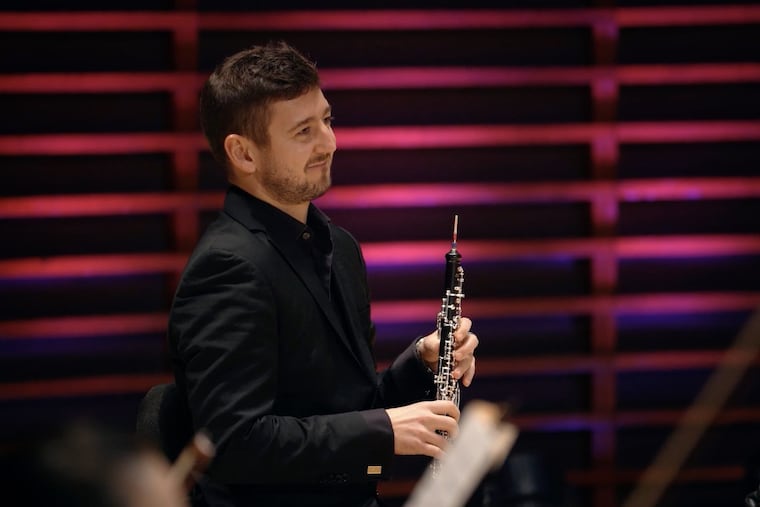Philippe Tondre earned his place among Philadelphia Orchestra oboe ‘legends’ in his soaring concerto debut
The new principal oboist takes the spotlight in the Mozart concerto, but is a vivid presence throughout this week's entire program.

One of the most reassuring sounds anywhere these days can be heard in this week’s Philadelphia Orchestra online concert: applause, warm and human. It comes not from a live audience, per se, but from orchestra members on stage at Verizon Hall in response to the first concerto appearance here of the ensemble’s new principal oboist.
Praise is warranted. Philippe Tondre arrived in the post at the start of this season, and though his sound has been a prominent one in the ensemble-lean repertoire the orchestra has undertaken lately, this week invites a new level of scrutiny.
Turns out that all three works on the program reveal different aspects of this key artist’s presence. He’s a team player in Haydn’s Symphony No. 44, adding a silvery edge to the overall sound of the floating third movement. He has a surprising cameo solo in the last movement of the Symphony No. 2 by the 18th-century — and now-suddenly popular — composer Joseph Bologne, Chevalier de Saint-Georges. And his performance of Mozart’s Oboe Concerto is sweet and soaring in all the right places.
Tondre drew criticism in some circles even before starting the job. The oboe section of this orchestra is known for being the home of a particular school of playing, and Tondre’s sound is more European. He follows Richard Woodhams, one of only three principal oboists to occupy the chair over the span of a century.
“I cannot express enough how much respect I have for them,” says Tondre of his predecessors in comments woven into this week’s production. “And I try to be as good as they’ve been because they are real legends. So, yeah, let’s see how I can figure it out.”
To these ears, he’s figured it out. Not only is he elegant and powerful in his ensemble work, but Tondre is a soloist in a way not all orchestral players are. In Mozart’s Oboe Concerto he’s got opinions that he expresses in stylish flourishes, like the way he takes those spiky grace notes just before the end. Technical challenges don’t exist for him, even in the most sustained phrases of the serene second movement or in mad-dash stretches of the first-movement cadenza. Tondre is a serious artist, and his influence could be a very good thing.
The concert brings another first. It marks the orchestra’s introduction to Saint-Georges, born in or around 1745 in Guadeloupe to a wealthy plantation owner and an enslaved woman from Senegal. Early on, his father took him to France, where he became a celebrated polymath: military man, fencer, violinist, conductor, and composer. Saint-Georges is being rediscovered by classical musicians, and here, in Dominique-René de Lerma’s edition, this short second symphony (just 10 minutes) receives a bright, crisp reading from the orchestra and music director Yannick Nézet-Séguin. With its Haydn-esque humor and focused, economical writing, the piece has enormous appeal. More from the composer, please.
The orchestra announced this program in early December, but in the intervening weeks it has only gained relevance. Haydn’s Symphony No. 44, subtitled “Trauersinfonie,” mirrors our inner lives at this moment. Classical folklore has it that Haydn wanted the slow movement of this “mourning symphony” played at his eventual funeral (it wasn’t).
Even more visceral perhaps to listeners now is the feeling through most of the symphony that tragedy sits just on the other side of a surprisingly thin line. Nézet-Séguin and the small ensemble generate not just heat, but also clarity. Transparent textures let Haydn’s storms speak for themselves, and they sometimes overwhelm (in a good way).
In a moment when we are all unavoidably absorbing outside events, Haydn’s work is remarkable for capturing and intensifying several distinct shades of peril. But it also leaves behind more than a residue of perspective and hope, which sure beats the endless cycle of social media doom-scrolling.
This week’s Philadelphia Orchestra program of works by Saint-Georges, Mozart, and Haydn streams Thursday at 8 p.m. and is available through Jan. 21 at 11 p.m. at philorch.org. Tickets are $17.